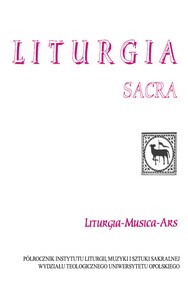The Idea of an ‘Icon in Sound’ in the Works of John Tavener
The Idea of an ‘Icon in Sound’ in the Works of John Tavener
Author(s): Joanna Miklaszewska Subject(s): Christian Theology and Religion, Music, History of Church(es), Eastern Orthodoxy, History of Art
Published by: Uniwersytet Opolski
Keywords: ‘icon in sound’; Orthodoxy; Byzantine music; musical symbolism; intertextuality; intermediality;
Summary/Abstract: The aim of this article is to present an innovative concept of the ‘icon in sound’ created by the English composer John Tavener. The first part of the article presents the intermedial and intertextual features of Tavener’s work, the second shows the genesis of the concept of ‘icon in sound’, to which three factors have contributed: 1) the composer’s interest in religious topics in his pieces, 2) the composer’s conversion to Orthodoxy, 3) collaboration with Mother Tekla, the author of the texts of many Tavener’s works. The last, third part of the article describes issues related to the formal structure and musical symbolism present in Tavener’s musical icons. The composer refers to painted icons by composing works characterised by static form and the expression of spirituality, mysticism and inner peace. These features result from the juxtaposing of melismatic structures, inspired by Byzantine music, with repetitive technique and dynamics often characterised by a low intensity. One characteristic of Tavener’s sound icons is a ‘luminous’ sound, achieved through the use of high registers of voices and instruments, which are combined with contemplative and lyrical expression. An important feature of John Tavener’s musical icons was the introduction of archaic elements, resulting primarily from the inspiration that the composer drew from the musical culture of the Orthodox Church (eg the use of Byzantine scales in Mary of Egypt, the introduction of instruments such as simantron in Mary of Egypt).
Journal: Liturgia Sacra
- Issue Year: XXVII/2021
- Issue No: 57
- Page Range: 217-231
- Page Count: 15
- Language: English

